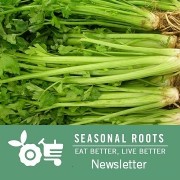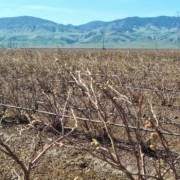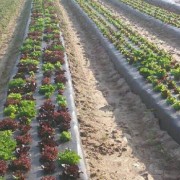How to throw just about all your local food on the barbie
– By the Veggie Fairy Team
You can cook a whole Labor Day meal on the grill, even if the food you’re making varies in how it should be cooked.
The secret
The secret to doing it is to create two zones, one for direct heat and one for indirect heat. So in a gas grill with two burners, turn one to medium high, the other to medium low; in charcoal grills, heap the coals to one side. The hotter side is your direct heat zone – the rest of the grill is the indirect heat zone.
Direct heat
This is ideal for small, tender foods that cook quickly. Things like sliced vegetables and fruits, corn on the cob, burgers, steaks, chops, boneless chicken, fish fillets, and shellfish. Direct heat sears the surface – developing flavors, textures, and caramelization – while cooking through to the center.
Indirect heat
This is better for larger, tougher foods that require longer cooking times. Think whole potatoes wrapped in foil, other dense root vegetables like turnips, and whole chickens, roasts, and racks of ribs. It’s also the best way to finish whole potatoes cooked without foil and bone-in cuts that are seared first over direct heat. Or vice versa for bone-in, skin-on chicken legs where you want crispy skin: Roast them first over indirect heat, then crisp the skin over direct heat.
Resource guides
Here are a few resources for grilling veggies, fruit, and meat:
A guide to grilling vegetables
A guide to grilling fruit
A guide to grilling meat
Naked or dressed?
Some things, like peppers, are perfect when you grill them “naked”, with nothing but some olive oil and salt. Other things are great when marinated. Here are some suggestions for marinating and combining your fresh local food on the grill this Labor Day. The marinades work just as well on veggies as on meat; marinate veggies or meat for at least an hour and then fire it up! You can find more ideas on our Pinterest page. Speaking of which, look at the old pin we found on our peach board!
HERB-GRILLED ELEPHANT GARLIC
Ingredients:
1 head elephant garlic, separated into cloves, sliced to desired thickness
1½ T olive oil
2 t fresh thyme, finely chopped
1 t fresh sage, finely chopped
½ t sugar, plus salt and pepper, to taste
Directions:
1. Toss garlic slices with oil. Sprinkle with salt, pepper, sugar.
2. Place on preheated grill for about 3 minutes each side.
3. Remove and cover with foil to continue cooking and keep warm.
4. Eat on freshly baked local bread, garnish grilled meat or veggies, or eat it straight up!
GRILLED GREENS & FRUIT with FETA
Ingredients:
1 bag Tuscan kale, washed, torn into bite-size pieces
4 peaches, halved
¼ c Greek feta cheese spread
¼ c olive oil
salt, pepper, garlic powder, to taste
1-2 T lemon juice
Optional: ¼ lb ground sage sausage
Directions:
1. Prepare ingredients while grill heats up.
2. Toss kale in a bowl with salt, pepper, garlic powder. Place it on foil and fold up to make an airtight pouch that’s still loose enough that kale can steam inside.
3. Toss peaches in bowl with oil.
4. Optional: form sausage into patties.
5. Place kale pouch, peaches, and optional sausage on heated grill. Peaches should be cut side down. Leave kale on grill for 10 – 12 minutes. Leave peaches until they’re thoroughly caramelized. If using sausage, cook it until it’s cooked through and through.
6. Make a bed of the kale. Top with peaches and crumbled sausage. Sprinkle with lemon juice and dot with feta.
MUSHROOM & SWISS BURGER
Also delish with pastured ground turkey or brats as a substitute for beef
TIP: If you go for handmade local brats, they’re delicate, so simmer them in beer in a saucepan on the stove until they’re cooked through, then finish them on the grill over direct heat.
Ingredients:
1¼ lbs grassfed ground beef
8 oz mushrooms, thinly sliced
¼ c onion chives, diced, or 1 small onion, thinly sliced
4 slices Swiss cheese
4 buns or 8 pieces of Bibb lettuce to wrap
2 T oil or butter
salt and pepper, to taste
Directions:
1. Prep grill for medium heat. Divide ground beef into 4 patties. Season with salt and pepper, to taste.
2. Heat oil or butter in a medium pan. If using onions, add to pan and saute for about 2-4 minutes. Add mushrooms and cook until tender, about 4 additional minutes. If using chives, add once mushrooms are done.
3. Grill patties about 5 min per side, until cooked to desired doneness. Toward end, add buns, cut side down, to toast.
4. Remove buns. Divide mushroom mixture among burgers, top with cheese. Cover grill for about 1 min to melt cheese.
5. Top with lettuce, or if you’re not using buns, use the lettuce to wrap the burgers in place of buns.
CITRUS MARINADE
Works on fresh local veggies just as well as on local pasture-raised chicken
1/4 c lemon juice
1/4 c lime juice
1/4 c olive oil
1 T orange zest
1 T fresh rosemary
1 T fresh thyme
1 clove garlic, minced
1/2 t salt
SWEET & SOUR MARINADE
1/2 c soy sauce
1/2 c ALFREDO’S BEEHIVE honey
1/4 c vinegar
1 T cornstarch
1 T water
1-1/2 t fresh ginger, grated
1 clove garlic, crushed
1/4 t black pepper
SAVORY GARLIC MARINADE
1/2 c balsamic vinegar
1/4 c soy sauce
3 T minced garlic
2 T honey
2 T olive oil
2 t black pepper
1 t Worcestershire sauce
1 t onion powder
1/2 t salt
1/2 t liquid smoke flavoring
pinch cayenne pepper
ABOUT SEASONAL ROOTS
Since 2011, Seasonal Roots’ online farmers market has connected Virginia families with local family farmers who use sustainable, humane practices. Our veggie fairies – mostly moms who believe in living better through scrumptious, healthy eating, being kind to animals, protecting the environment, and spreading joy – home-deliver freshly harvested produce, pastured eggs, grassfed dairy and meat, plus artisan fare. We empower our members to eat better and live better with more nutritious, flavorful food that’s good for us and good for the planet. More info at seasonalroots.com.


















